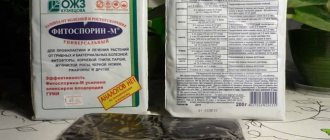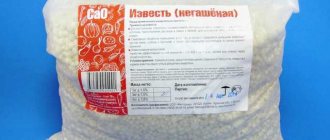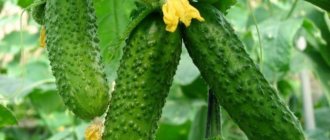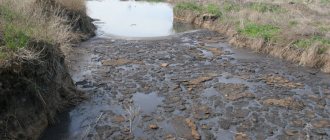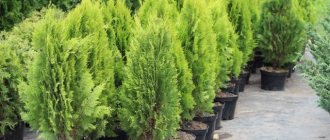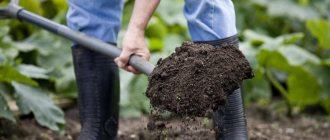Add organic materials
An acidic reaction can be obtained by adding organic products. The most popular of them:
- Fresh manure. It contains a large amount of nitrogen, which allows the fertilizer to be used to acidify the soil. When applying 3 kg of fertilizer per 1 m2 of land, it is possible to reduce the pH level by 1 unit and increase acidity.
- Leaf compost. The product not only improves soil structure, but is also an excellent acidifier for acidophilic plants. It is recommended to apply the composition in the spring before digging, and also use it for mulching, and include it in the nutrient soil mixture before planting seedlings.
- High peat. Has high acidity. It is used in the autumn when digging beds. Application rate – 1.5 kg per 1 m2.
Organic components decompose in the soil, resulting in the formation of byproducts. The acidification process is slow, but the effectiveness is maintained over a long period.
How to reduce soil acidity (make it neutral)
Most often, gardeners are faced with the fact that the soil in their garden is too acidic (pH below 5.5), which means it needs to be deoxidized (increasing pH). To do this, you need to add one of the deoxidizers to the soil, and they also say liming it.
When, how to properly and often deoxidize the soil
It is customary to deoxidize the soil in the fall .
So, first you need to scatter the deoxidizer (lime material) in an even layer over the surface of the bed, and then embed it into the soil (dig it with a spatula or loosening).
Important! It is obvious that the effectiveness of liming directly depends on the uniform application of liming materials and their thorough mixing with the soil.
And a few more rules:
- All deoxidizers can be applied during autumn digging with organic fertilizers (manure, humus, compost), except that wood ash and manure should not be mixed .
- But mixing lime materials with phosphorus and nitrogen fertilizers is not recommended, because they will make them inaccessible to plants.
Worth knowing! Lime dissolves quite slowly in the soil, which means that its deoxidizing effect will be carried out gradually, in other words, the maximum effect will be achieved only 1-2 years after application (but not the next year!)
If you carry out deoxidation according to all the rules (add the required amount of calcareous material to the soil), the effect will last for 5-7 years (the heavier the soil, the longer), and then you will need to repeat liming (deoxidation) of the soil .
Interest Ask! Is it possible to add a deoxidizer to the holes before planting?
This will clearly not be enough, because... The root system of the plant will eventually extend beyond a certain (diameter) hole. The deoxidizer should be applied along the entire perimeter of the bed.
How to deoxidize the soil: popular deoxidizers (lime materials)
To deoxidize the soil, as a rule, use:
- Dolomite (limestone) flour;
Using dolomite (limestone) flour is the most popular method of soil deoxidation.
- Slaked lime (fluff);
- Wood ash;
By the way! Ash can be used if you want to achieve the fastest possible effect.
- Chalk;
- Any other special deoxidizer (for example, Lime-Gumi Deoxidizer , which, in addition to direct deoxidation, also heals and increases soil fertility).
Important! Under no circumstances use soda . The fact is that excess sodium in the soil has a very bad effect on the physical properties of the soil.
Norms for applying deoxidizers to the soil
Obviously, the rate of application of one or another deoxidizing agent depends on the initial acidity of the soil: the more acidic it is, the more deoxidizing (lime) substance is required.
Accordingly, before you begin deacidification, you need to determine the acidity of the soil .
And also on the type of soil (mechanical composition) : on light (sandy or sandy loam) soils, the application rate should be 1.5 times less than on heavy (clay or loamy) soils.
For example, application rates for slaked lime for heavy (loamy) soil :
- acidic (pH less than 4.5) - 500-600 grams per sq.m. beds;
- medium acidic (pH 4.5-5.5) - 450-500 g per square meter;
- slightly acidic (pH 5.2-5.5) - 350-450 g per sq.m.
Accordingly, for sandy loam (light) soils the norms will be 1.5 less.
Wood ash contains almost 2 or even 3 times less calcium (on average - 30-40%) than lime and dolomite flour (up to 85%), in other words, the application rate increases to 0.7-1.2 kg per square meter. beds _ But the ash contains many other useful micro- and macroelements (potassium, phosphorus, magnesium, iron, sulfur, boron, manganese, zinc, molybdenum). The main advantage of wood ash is the rapid neutralization of acidic soil .
In other words, it makes sense to use wood ash only for the rapid deacidification of medium or slightly acidic soil (pH 4.5-5.2 or 5.2-5.5).
The application rates for dolomite (limestone) flour are usually indicated on the packaging.
By the way! The site already has detailed material on how to use dolomite flour to deoxidize the soil .
As for the application rates of the Lime-Gumi Deoxidizer ,
then again, everything is on the back of the package.
Acidify with minerals
To increase the acidity of heavy clay soils, mineral additives are often used. Colloidal sulfur is popular. Its use ensures an increase in acidity levels by 2.5 units.
The product is applied to the soil to a depth of 12-15 cm before winter. The recommended consumption rate is 1 kg per 10 m2. After applying fertilizer, the result is observed on average after 1 year.
Ferrous sulfate is also an effective soil acidification agent. It has a mild action. In 1 month, the pH value decreases by 1 unit, and acidity increases. Apply 0.5 kg of substance per 1 m2.
Change in soil acidity
Let’s assume that you have determined the acidity, which means you can move on to changing it in the required direction.
Let's immediately define the basic concepts and their synonyms:
- Soil deacidification = reducing its acidity (increasing the pH level to 6-7) = neutralizing soil acidity (bringing it to normal) = liming (since calcareous materials containing calcium are used for deacidification).
- Soil acidification = increasing its acidity (lowering the pH level to 4.5-5.5).
Use sulfuric acid or vinegar
Concentrated sulfuric acid (1 tsp) is dissolved in 1 bucket of water. The soil is watered with an acidified mixture. Soil acidity increases by 1-2 units.
To avoid accidentally harming the plant crop, it is preferable to use diluted acid. It can be purchased as an electrolyte for a lead acid battery at a car dealership. 50 ml of this product is diluted in 10 liters of water. The acidification procedure is carried out repeatedly throughout the growing season. Dilute acid is safe for plants; it provides a smooth increase in acidity.
When using 9% vinegar, half a glass of the product is diluted in 1 bucket of water. This option for soil acidification has a short-term effect and helps destroy soil microflora.
How to determine soil acidity level
Only a laboratory can provide an extremely accurate analysis. Soil samples should be taken before purchasing or long-term renting a plot. But you can determine the level of acidification using improvised means:
- litmus indicators;
- soda;
- type of weed;
- vinegar;
- pH meter (soil probe).
The simplest option is an indicator made of litmus paper and soda. You can buy a litmus indicator at any hardware store and use it like this:
What green manure is best used to deoxidize the soil on the site?
- Dig holes with a smooth wall about the depth of a spade bayonet throughout the area. Dig diagonally.
- In all holes, remove a thin layer of soil from the wall.
- Take a sample of 20 grams from each portion from the hole. Stir in a glass of water and let stand.
- Dip litmus into water (according to instructions), then determine the acidity level of the soil.
Depending on the degree of acid content, the paper will turn a certain color:
- blue – alkaline soil;
- greenish – neutral;
- yellow tint – weak acidity;
- orange litmus will indicate an average level of acidity;
- red color – the soil is acidic.
To test the soil without purchased products, you need to mix water and soil in a small cup. Sprinkle generously with baking soda on top. If the soda reacts and hisses, the soil is acidified. But the degree of acidity cannot be determined with soda.
Plant green manure
An effective way is to plant plants whose roots contain large amounts of organic acids. These include:
- mustard;
- rape;
- oats;
- soy;
- lupine.
These plant crops also have a phytosanitary effect, ridding the soil of pests and preventing the development of many diseases.
The attitude of plants to soil acidity. Types of acidity.
- Neutral
- Slightly acidic
- Sour
- Strongly acidic
Neutral
Most plants prefer soil acidity with a neutral pH or close to neutral - from 6.2 to 7.5 :
- Cabbage.
- Beet.
- Peas.
- Celery.
- Cucumber.
- Salad.
- Bulb onions.
- Asparagus.
- Parsley.
- Carrot.
- Turnip.
Slightly acidic
Slightly acidified soils, from 6 to 7 pH, like the following crops:
- Beans.
- Dill.
- Tomato
- Eggplant.
- Corn.
- Melon.
- Zucchini.
- Squash.
- Horseradish.
- Spinach.
- Rhubarb.
- Carrot.
- Garlic.
- Collard greens.
- Radish.
- Brussels sprouts.
- Chicory.
- Watermelon.
- Different types of onions: chives, shallots, etc.
Sour
A very small proportion of edible garden crops prefer more acidic soil options, with pH values from 5.0 to 6.5 :
- Potato.
- Pepper.
- Beans.
- Sorrel.
- Parsnip.
- Pumpkin.
Strongly acidic
No vegetable garden crop likes more acidic soils. But, nevertheless, there are plants that grow in acidic soil with pH levels below 5.0 :
- Blueberry.
- Cranberry.
- Rowan.
- Blueberry.
- Cowberry.
- Juniper.
It turns out that where potatoes feel quite good, you may not get any harvest of tomatoes, celery, beets, cabbage, onions and many other vegetables.
Why is acidic soil dangerous in the garden?
- Increased soil acidity inhibits the growth and development of plants. This happens due to the fact that in acidic soils the content of soluble aluminum and its salts, as well as manganese, predominates, which bind alkaline minerals: calcium, magnesium, potassium, selenium, etc., preventing their absorption by plants.
- Protein and carbon metabolic processes in plants are disrupted, which is why reproductive organs may not appear at all, which leads to loss of yield.
- In acidic soil, pathogenic bacteria and microorganisms, as well as pests, multiply faster and more actively.
- At the same time, the development and reproduction of soil-forming bacteria, which are beneficial microorganisms, is inhibited. Manure, peat and other organic matter introduced into the soil no longer decompose and are not converted into food available to plants. In combination with the previous point, this leads to an imbalance in the soil.
- Bacteria that absorb nitrogen from the air die, which then accumulates in the ground.
- The more acidic the soil, the faster it becomes waterlogged . After some time, only some swamp regulars and coniferous plants will be able to grow on it.
Soil acidity, which is increasing at a furious rate, is one of the most important and acute environmental problems of modern society. The trend is that over time an environmental agrogeochemical disaster may occur. That is why every zealous owner, even if he does not have hectares of land, but only a dacha plot of 6 acres, must be aware of the actions he is taking and approach the issue of harvesting in a comprehensive manner, trying to imitate nature as much as possible.
Why acidify the soil?
Low acidity of the soil contributes to a decrease in its fertility and agrophysical properties. When exposed to an alkaline reaction, valuable microelements undergo structural changes, which makes it impossible for them to be absorbed by the plant crop. As a result of a lack of minerals and vitamins in an alkaline environment, the culture begins to grow and develop worse.
Due to the low acidity of the soil, the water-physical properties of the soil deteriorate. It becomes denser and its breathability decreases. After rain or watering, a dense crust forms on its surface. All these factors negatively affect plant growth and productivity.
Crops that prefer acidic soils
Many flowers will do well in acidic soils:
- carnations;
- zinnias;
- anthuriums;
- delphiniums;
- hyacinths;
- gladioli;
- chrysanthemums;
- crocuses;
- tulips;
- roses;
- petunias and many others.
There are lovers of acidic soils among shrubs and trees. This, of course, includes most conifers, junipers and acacias, as well as birches, rhododendrons, heather, dogwoods and magnolias. You can add cranberries, hydrangeas, viburnum and Japanese quince to the same list.
